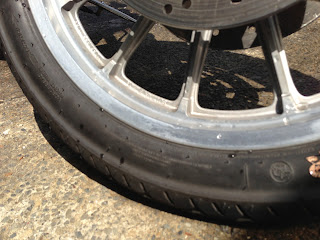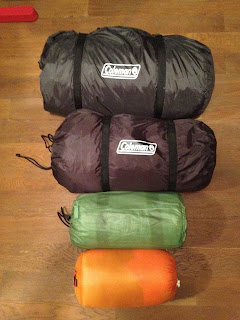In this episode, I would like to talk about camping gears and tools I have in addition to the "5 must-have-items" I introduced last time.
There are so many tools/gears available to make your camping trip more comfortable and enjoyable.
Since "camp-touring" on motorcycle limits the amount of luggage you can take, you will need to carefully select what you want to bring with you. Also, enjoy "riding" to the camping site is another goal for us, we want to pack small and minimize the effect to drivability/maneuverability.
Selecting the tools/gears for the camping trip is actually my favorite part of the camp-touring. Thinking about trying out a new tool (toy!?) I got online before the trip, what to cook, what kind of local drinks available in the region I am going to...etc; I really enjoy the preparation process.
The 5 must have items are the following:
1. Tent
2. Sleeping bag
3. Sleeping pad
4. Lantern/flashlight
5. Bug repellent
(The top black bag is my main tent, Coleman Phad X3. 2nd one is Coleman Avior X2 tent. Green bag is my Coleman Compact Inflator Mat II L sleeping pad. Orange bag is a NANGA down sleeping bag)
To set up a tent, you will need a hammer and pegs.
My lantern (Micro-quad lantern by Coleman) and headlight. Don't forget bringing extra batteries.
Here are the rest of tools and gears I have (for one-night camping trip).
- Tarp or ground-sheet for tent (blue tarp)
I lay this under the tent to prevent damage of my tent's bottom and moisture from the ground. My tent (and most of tents) has waterproof bottom but it still gets wet sometime. Using a tarp makes much easier to dry and clean-up the tent next day before you put it away. The one I have is know as "blue-sheet" in Japan. It is about 200-500 yen and you can find in many stores.
- Portable table (Red bag)
This is by a Japanese camping/outdoor manufacture, Snowpeak. This low-table is perfect for small chair and sitting on ground. Its photo is at the top of this episode.
- Portable chair (camouflage-printed bag)
I prefer to have a larger chair (with armrest) but it is too large to load it on my motorcycle (some people still bring though). This folding chair, as you can see in the photo, can be packed so small. At the camp site, I often sit on the picnic sheet and use this chair as a small table.
- Portable windshield (silver rectangular metal above the sandals)
*This windshield is for a camp stove. It make a big difference in windy condition. I always bring this just in case.
- Picnic sheet (roll-up checkered one)
This is by Coleman. The size is just right for one or two person (140 x 90 cm). The backside of the sheet is waterproof. Eat, drink, read, lay dawn and take a nap... how nice!
- Sandals
It is more comfortable wearing those at the camp site and also makes easier to go in and out of tent.
- Hanger
I use this to dry towels and gloves or other riding gears if they get wet. And of course it can be used to hang your jacket.
- Camp stove
Two major types used for camp-touring: cartridge gas and fuel (white gasoline or regular gasoline). I recommend the gas type. It is easy to use and very small when it is packed.
- Pots, pans
You can find variety of pot/pan cook-sets in diffident shapes and sizes. Most of them are stackable. I use them as dishes too.
-Cup or mug
I bring a mug-cup and use this for my coffee, sake, wine, soup... everything.
- Pot / Mess Aluminum Tin (aka mess-tin) by Trangia
This simple aluminum rectangular-shape cooking pot is very nice. I use this to cook rice. Because of its shape, you can store small cooking items inside very well.
- Dish soap
I bring it in a small container (I am using a small plastic bottle with a top and I think this is for cosmetic use, originally) and also use a eco-friendly one.
-Water jug
I use a foldable water bottle/jug by Platypus (2 litter). You can also use a pet-bottle
-Wine container
This is also by Platypus. You can save some room and also do not worry about trashing empty bottle (many camping sites ask you to take your trash home with you).
- Bug repentant, insect bite reliever, alcohol wipe, band-aide...etc
- Radio
I love listening baseball game on radio. Also, you can catch a weather news where there is no mobile phone signal.
- Motorcycle Kick Stand Coaster (bottom right on the photo)
I recommend taking this to a camp-touring. Motorcycles are heavy pieces of machinery and unless you're on concrete, the kick stand might slowly dig into the ground overnight because of the weight and your motorcycle may go down by the time you wake up in the morning. This prevents your motorcycle from tumbling over. You can also use a piece of wood or rock (make sure it is stable enough).
In addition, I like to bring a portable BBQ grill. Some Japanese local manufactures make many great products. Here is one of them and my favorite. This is made by a small factory, Sho's (笑's). They make amazingly compact yet tough BBQ grills.
This grill is [B-6 kun (B-6君)] and can be folded to B-6 size.
The bottom of the grill has some openings with good airflow for a high combustion efficiency. You can burn some logs or charcoal and enjoy BBQ. I love buying some meet, fish, and veggies, put them on grill, and enjoy a cigar and good drinks! Don't forget bringing soy source and crazy salt; they make everything taste good ;-)
Those items listed above are just examples. You can bring anything you want as long as the luggage space of your motorcycle permits. As you go on the camping, you will find out what you need and what you don't use. More importantly, you will find out what you want NEXT!
Welcome to the crazy world of outdoor-item shopping!
Soon, AMAZON will be your best buddy. Enjoy!
If you enjoy this blog, please click the below icons for blog popularity ranking.
Thanks!
Please also visit my other blogs:











































